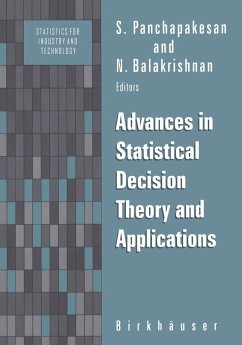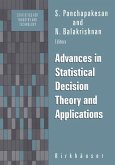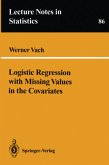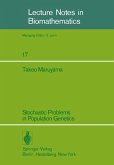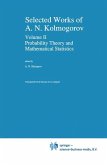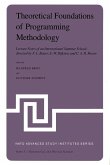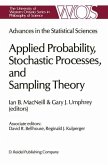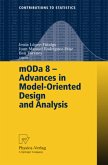Panchapakesan
Advances in Statistical Decision Theory and Applications
Herausgegeben von Panchapakesan, S.; Balakrishnan, N.
Panchapakesan
Advances in Statistical Decision Theory and Applications
Herausgegeben von Panchapakesan, S.; Balakrishnan, N.
- Gebundenes Buch
- Merkliste
- Auf die Merkliste
- Bewerten Bewerten
- Teilen
- Produkt teilen
- Produkterinnerung
- Produkterinnerung
Shanti S. Gupta has made pioneering contributions to ranking and selection theory; in particular, to subset selection theory. His list of publications and the numerous citations his publications have received over the last forty years will amply testify to this fact. Besides ranking and selection, his interests include order statistics and reliability theory. The first editor's association with Shanti Gupta goes back to 1965 when he came to Purdue to do his Ph.D. He has the good fortune of being a student, a colleague and a long-standing collaborator of Shanti Gupta. The second editor's…mehr
Andere Kunden interessierten sich auch für
![Advances in Statistical Decision Theory and Applications Advances in Statistical Decision Theory and Applications]() Advances in Statistical Decision Theory and Applications38,99 €
Advances in Statistical Decision Theory and Applications38,99 €![Logistic Regression with Missing Values in the Covariates Logistic Regression with Missing Values in the Covariates]() Werner VachLogistic Regression with Missing Values in the Covariates39,99 €
Werner VachLogistic Regression with Missing Values in the Covariates39,99 €![Stochastic Problems in Population Genetics Stochastic Problems in Population Genetics]() T. MaruyamaStochastic Problems in Population Genetics39,99 €
T. MaruyamaStochastic Problems in Population Genetics39,99 €![Selected Works II Selected Works II]() Andrei N. KolmogorovSelected Works II92,99 €
Andrei N. KolmogorovSelected Works II92,99 €![Theoretical Foundations of Programming Methodology Theoretical Foundations of Programming Methodology]() M. Broy (ed.) / Günther SchmidtTheoretical Foundations of Programming Methodology40,99 €
M. Broy (ed.) / Günther SchmidtTheoretical Foundations of Programming Methodology40,99 €![Advances in the Statistical Sciences: Applied Probability, Stochastic Processes, and Sampling Theory Advances in the Statistical Sciences: Applied Probability, Stochastic Processes, and Sampling Theory]() Advances in the Statistical Sciences: Applied Probability, Stochastic Processes, and Sampling Theory39,99 €
Advances in the Statistical Sciences: Applied Probability, Stochastic Processes, and Sampling Theory39,99 €![mODa 8 - Advances in Model-Oriented Design and Analysis mODa 8 - Advances in Model-Oriented Design and Analysis]() Jesús López-Fidalgo / Juan Manuel Rodríguez-Díaz / Ben Torsney (eds.)mODa 8 - Advances in Model-Oriented Design and Analysis75,99 €
Jesús López-Fidalgo / Juan Manuel Rodríguez-Díaz / Ben Torsney (eds.)mODa 8 - Advances in Model-Oriented Design and Analysis75,99 €
Shanti S. Gupta has made pioneering contributions to ranking and selection theory; in particular, to subset selection theory. His list of publications and the numerous citations his publications have received over the last forty years will amply testify to this fact. Besides ranking and selection, his interests include order statistics and reliability theory. The first editor's association with Shanti Gupta goes back to 1965 when he came to Purdue to do his Ph.D. He has the good fortune of being a student, a colleague and a long-standing collaborator of Shanti Gupta. The second editor's association with Shanti Gupta began in 1978 when he started his research in the area of order statistics. During the past twenty years, he has collaborated with Shanti Gupta on several publications. We both feel that our lives have been enriched by our association with him. He has indeed been a friend, philosopher and guide to us.
Produktdetails
- Produktdetails
- Statistics for Industry and Technology .
- Verlag: Birkhäuser Basel / Springer, Basel
- 1997.
- Seitenzahl: 498
- Erscheinungstermin: 23. September 1997
- Englisch
- Abmessung: 260mm x 180mm x 25mm
- Gewicht: 1070g
- ISBN-13: 9780817639655
- ISBN-10: 0817639659
- Artikelnr.: 27302455
- Herstellerkennzeichnung
- Libri GmbH
- Europaallee 1
- 36244 Bad Hersfeld
- gpsr@libri.de
- Statistics for Industry and Technology .
- Verlag: Birkhäuser Basel / Springer, Basel
- 1997.
- Seitenzahl: 498
- Erscheinungstermin: 23. September 1997
- Englisch
- Abmessung: 260mm x 180mm x 25mm
- Gewicht: 1070g
- ISBN-13: 9780817639655
- ISBN-10: 0817639659
- Artikelnr.: 27302455
- Herstellerkennzeichnung
- Libri GmbH
- Europaallee 1
- 36244 Bad Hersfeld
- gpsr@libri.de
N. Balakrishnan is an Associate Director and Professor at Department of Aerospace Engineering and Supercomputer Edu- cation and Research Centre, Indian Institute of Science. His research interests include numerical electromagnetic, multi-parameter radars, and signal processing. His publications include 19 books and many peer-reviewed journal papers.
I: Bayesian Inference.- 1 Bayes for Beginners? Some Pedagogical Questions.- 1.1 Introduction.- 1.2 Unfinished Business: The Position of Bayesian Methods.- 1.3 The Standard Choice.- 1.4 Is Bayesian Reasoning Accessible?.- 1.5 Probability and Its Discontents.- 1.6 Barriers to Bayesian Understanding.- 1.7 Are Bayesian Conclusions Clear?.- 1.8 What Spirit for Elementary Statistics Instruction?.- References.- 2 Normal Means Revisited.- 2.1 Introduction.- 2.2 Selection Criteria.- 2.3 Model and Computations.- 2.4 Numerical Example.- References.- 3 Bayes m-Truncated Sampling Allocations for Selecting the Best Bernoulli Population.- 3.1 Introduction.- 3.2 General Outline of Bayes Sequential Sampling Allocations.- 3.3 Allocations for Bernoulli Populations.- 3.4 Numerical Results and Comparisons.- References.- 4 On Hierarchical Bayesian Estimation and Selection for Multivariate Hypergeometric Distributions.- 4.1 Introduction.- 4.2 Formulation of the Problems.- 4.2.1 Bayesian estimation of si, i=1,..., n.- 4.2.2 Bayesian selection rule.- 4.3 A Hierarchical Bayesian Approach.- 4.4 Optimality of the Hierarchical Bayesian Procedures.- 4.4.1 Optimality of ?H.- 4.4.2 Optimality of ?H.- References.- 5 Convergence Rates of Empirical Bayes Estimation and Selection for Exponential Populations With Location Parameters.- 5.1 Introduction.- 5.2 Bayes Estimators and Bayes Selection Rule.- 5.3 Empirical Bayes Estimators and Empirical Bayes Selection Rule.- 5.4 Asymptotic Optimality of the Empirical Bayes Estimators.- 5.5 Asymptotic Optimality of the Empirical Bayes Selection Rule.- 5.6 An Example.- References.- 6 Empirical Bayes Rules for Selecting the Best Uniform Populations.- 6.1 Introduction.- 6.2 Empirical Bayes Framework of the Selection Problem.- 6.3 Estimation of the Prior Distribution.- 6.3.1 Construction of the prior estimator.- 6.3.2 Consistency of the estimator.- 6.4 The Proposed Empirical Bayes Selection Procedure.- 6.5 Rates of Convergence.- References.- II: Decision Theory.- 7 Adaptive Multiple Decision Procedures for Exponential Families.- 7.1 Introduction.- 7.2 Adaptation for Exponential Families.- 7.3 Gamma Distributions Family.- 7.4 Normal Family.- References.- 8 Non-Informative Priors Via Sieves and Packing Numbers.- 8.1 Introduction.- 8.2 Preliminaries.- 8.3 Jeffreys' Prior.- 8.4 An Infinite Dimensional Example.- References.- III: Point And Interval Estimation-Classical Approach.- 9 From Neyman's Frequentism to the Frequency Validity in the Conditional Inference.- 9.1 Introduction.- 9.2 Frequency Validity under Model 1.- 9.3 Generalizations.- 9.3.1 Other statistical procedures.- 9.3.2 Frequency validity under Model 2 involving different experiments.- 9.4 Conclusions.- References.- 10 Asymptotic Theory for the Simex Estimator in Measurement Error Models.- 10.1 Introduction.- 10.2 The SIMEX Method.- 10.2.1 Simulation step.- 10.2.2 Extrapolation step.- 10.2.3 Sketch of asymptotics when B = ?.- 10.3 General Result and Logistic Regression.- 10.3.1 The general result.- 10.3.2 Logistic regression.- 10.4 SIMEX Estimation in Simple Linear Regression.- References.- 11 A Change Point Problem for Some Conditional Functionals.- 11.1 Introduction.- 11.2 Regularity Conditions and the Main Result.- 11.3 Some Discussions.- References.- 12 On Bias Reduction Methods in Nonparametric Regression Estimation.- 12.1 Introduction.- 12.2 The Bias Reduction Methods.- 12.3 A Monte Carlo Study.- References.- 13 Multiple Comparisons With the Mean.- 13.1 Different Types of Multiple Comparisons.- 13.2 Balanced MCM.- 13.3 Unbalanced MCM.- 13.3.1 Comparisons with the weighted mean.- 13.3.2 Comparisons with the unweighted mean.- 13.4 Recommendations.- References.- IV: Tests Of Hypotheses.- 14 Properties of Unified Bayesian-Frequentist Tests.- 14.1 Introduction.- 14.2 The New Bayesian-Frequentist Test.- 14.3 Normal Testing.- 14.4 The "Two-Sided" Normal Test With Shifted Conjugate Prior.- 14.5 The "Two-Sided" Test With Uniform Prior.- 14.6 Lower Bound on ? .- 14.7 Th
I: Bayesian Inference.- 1 Bayes for Beginners? Some Pedagogical Questions.- 1.1 Introduction.- 1.2 Unfinished Business: The Position of Bayesian Methods.- 1.3 The Standard Choice.- 1.4 Is Bayesian Reasoning Accessible?.- 1.5 Probability and Its Discontents.- 1.6 Barriers to Bayesian Understanding.- 1.7 Are Bayesian Conclusions Clear?.- 1.8 What Spirit for Elementary Statistics Instruction?.- References.- 2 Normal Means Revisited.- 2.1 Introduction.- 2.2 Selection Criteria.- 2.3 Model and Computations.- 2.4 Numerical Example.- References.- 3 Bayes m-Truncated Sampling Allocations for Selecting the Best Bernoulli Population.- 3.1 Introduction.- 3.2 General Outline of Bayes Sequential Sampling Allocations.- 3.3 Allocations for Bernoulli Populations.- 3.4 Numerical Results and Comparisons.- References.- 4 On Hierarchical Bayesian Estimation and Selection for Multivariate Hypergeometric Distributions.- 4.1 Introduction.- 4.2 Formulation of the Problems.- 4.2.1 Bayesian estimation of si, i=1,..., n.- 4.2.2 Bayesian selection rule.- 4.3 A Hierarchical Bayesian Approach.- 4.4 Optimality of the Hierarchical Bayesian Procedures.- 4.4.1 Optimality of ?H.- 4.4.2 Optimality of ?H.- References.- 5 Convergence Rates of Empirical Bayes Estimation and Selection for Exponential Populations With Location Parameters.- 5.1 Introduction.- 5.2 Bayes Estimators and Bayes Selection Rule.- 5.3 Empirical Bayes Estimators and Empirical Bayes Selection Rule.- 5.4 Asymptotic Optimality of the Empirical Bayes Estimators.- 5.5 Asymptotic Optimality of the Empirical Bayes Selection Rule.- 5.6 An Example.- References.- 6 Empirical Bayes Rules for Selecting the Best Uniform Populations.- 6.1 Introduction.- 6.2 Empirical Bayes Framework of the Selection Problem.- 6.3 Estimation of the Prior Distribution.- 6.3.1 Construction of the prior estimator.- 6.3.2 Consistency of the estimator.- 6.4 The Proposed Empirical Bayes Selection Procedure.- 6.5 Rates of Convergence.- References.- II: Decision Theory.- 7 Adaptive Multiple Decision Procedures for Exponential Families.- 7.1 Introduction.- 7.2 Adaptation for Exponential Families.- 7.3 Gamma Distributions Family.- 7.4 Normal Family.- References.- 8 Non-Informative Priors Via Sieves and Packing Numbers.- 8.1 Introduction.- 8.2 Preliminaries.- 8.3 Jeffreys' Prior.- 8.4 An Infinite Dimensional Example.- References.- III: Point And Interval Estimation-Classical Approach.- 9 From Neyman's Frequentism to the Frequency Validity in the Conditional Inference.- 9.1 Introduction.- 9.2 Frequency Validity under Model 1.- 9.3 Generalizations.- 9.3.1 Other statistical procedures.- 9.3.2 Frequency validity under Model 2 involving different experiments.- 9.4 Conclusions.- References.- 10 Asymptotic Theory for the Simex Estimator in Measurement Error Models.- 10.1 Introduction.- 10.2 The SIMEX Method.- 10.2.1 Simulation step.- 10.2.2 Extrapolation step.- 10.2.3 Sketch of asymptotics when B = ?.- 10.3 General Result and Logistic Regression.- 10.3.1 The general result.- 10.3.2 Logistic regression.- 10.4 SIMEX Estimation in Simple Linear Regression.- References.- 11 A Change Point Problem for Some Conditional Functionals.- 11.1 Introduction.- 11.2 Regularity Conditions and the Main Result.- 11.3 Some Discussions.- References.- 12 On Bias Reduction Methods in Nonparametric Regression Estimation.- 12.1 Introduction.- 12.2 The Bias Reduction Methods.- 12.3 A Monte Carlo Study.- References.- 13 Multiple Comparisons With the Mean.- 13.1 Different Types of Multiple Comparisons.- 13.2 Balanced MCM.- 13.3 Unbalanced MCM.- 13.3.1 Comparisons with the weighted mean.- 13.3.2 Comparisons with the unweighted mean.- 13.4 Recommendations.- References.- IV: Tests Of Hypotheses.- 14 Properties of Unified Bayesian-Frequentist Tests.- 14.1 Introduction.- 14.2 The New Bayesian-Frequentist Test.- 14.3 Normal Testing.- 14.4 The "Two-Sided" Normal Test With Shifted Conjugate Prior.- 14.5 The "Two-Sided" Test With Uniform Prior.- 14.6 Lower Bound on ? .- 14.7 Th

